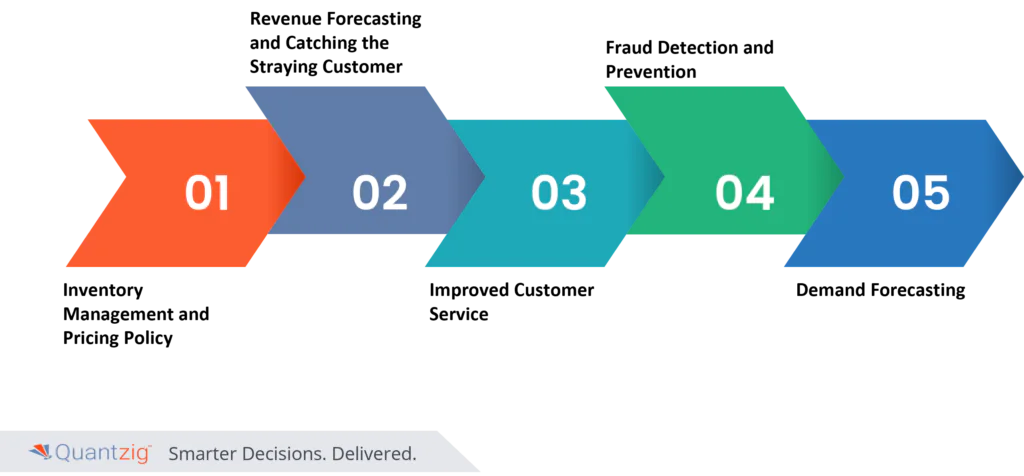The retail industry, with its dynamic nature and ever-evolving consumer preferences, faces numerous challenges that can impact operational efficiency and profitability. One powerful tool that has emerged to address these challenges is retail predictive analytics. By leveraging data-driven insights and advanced analytics, retailers can overcome obstacles and optimize various facets of their operations. Let’s delve into five significant challenges tackled by retail predictive analytics.
Table of Contents
The Global Retail Industry – An Overview
The retail industry today has more access to customer data than ever before. However, this data doesn’t always translate into successful outcomes. Today, retailers are more hard-pressed to convert user customer information into actionable insights that give them an edge over others in attracting future sales. But in most cases, retailers are unsure of how exactly to put the available data into use. What retail companies need is to find a way to gain actionable information that will help them track not just what’s currently selling, but what will sell in the future. Predictive analytics is the ideal solution to this.
Retail predictive analytics is concerned with the micro-level (i.e. down to a specific individual) rather than macro-level predictions that are based on averages or generalities. By using predictive analytics, retail industry players can take into account each individual and evaluate their purchases in real-time to accurately predict what they are most likely to buy based on their specific buying habits. In this article, we present some crucial retail industry problems that can be brought under control using predictive analytics.
Quantzig’s portfolio of specially curated analytics solutions for the retail sector comprises unique solutions that tap into both quantitative and qualitative data sets to provide actionable insights aimed at driving outcomes and optimizing clients’ business processes. Schedule a free one-on-one demo to learn more about our offerings.
Challenges Tackled by Retail Predictive Analytics

The retail industry, with its dynamic nature and ever-evolving consumer preferences, faces numerous challenges that can impact operational efficiency and profitability. One powerful tool that has emerged to address these challenges is retail predictive analytics. By leveraging data-driven insights and advanced analytics, retailers can overcome obstacles and optimize various facets of their operations. Let’s delve into five significant challenges tackled by retail predictive analytics.
1. Inventory Management
When retail companies have a poor inventory management system in place, it can often result in loss of sale situations for the business. This, in turn, will create a picture of lower demand for certain items, making future order predictions based on that past data inherently inaccurate. Savvy retailers use advanced capabilities like predictive analytics that provide real-time data to move inventory where it’s needed before it’s late.
2. Pricing Policy
Predictive analytics is a highly useful tool in setting retail prices. This technique allows companies in the retail industry to set prices after taking into account all possible factors in real-time. Besides, considering competitors’ pricing, using predictive analytics, retailers can take into account everything from real-time sales data to information about whether to optimize prices for a particular point in time.
3. Revenue Forecasting
Forecasting revenue based on historical sales and customer data may not be a practical method anymore. This is mainly because there are also chances that a few of those customers could have switched to competitor brands. Predictive analytics generates more accurate forecasts based on the predicted buying habits of new customers of the brand.
4. Catching the Straying Customer
Bringing back a loyal customer who appears to be disengaging from your brand is an arduous task indeed. Especially, in today’s market scenario where customers are spoilt for choice. With the help of predictive analytics, retailers can understand which customer is straying, which customer has the potential to be a long-term user, and which shopper will make his next purchase.
Request for more information to find out how we help retailers to enhance operations using data-driven strategies.
5. Improved Customer Service
As predictive analytics helps companies in the retail industry to know their customer in a better way, it would help them in an appropriate marketing plan. Similarly, before talking to the customer, it is important to know about their basic interests, likes, and dislikes. Retailers can help them make informed decisions, perform better social media marketing and answer on-site queries by leveraging predictive analytics.
6. Fraud Detection and Prevention
Retailers face constant threats from fraudulent activities, including payment fraud, account takeovers, and fake returns. Predictive analytics can analyze transaction patterns, user behavior, and historical data to detect anomalies indicative of fraudulent activities. By leveraging machine learning algorithms, retailers can proactively identify and mitigate potential fraud risks, protecting both themselves and their customers.
7. Demand Forecasting
Anticipating customer demand is crucial for optimizing stock levels, production, and supply chain processes. Traditional forecasting methods often fall short in capturing the complexities of modern consumer behavior. Retail predictive analytics utilizes machine learning algorithms to analyze vast datasets, providing more accurate and granular demand forecasts. This enables retailers to align their inventory with actual demand, reducing excess stock and avoiding stockouts.
In the highly competitive and rapidly evolving landscape of the retail industry, predictive analytics emerges as a powerful ally. By addressing challenges related to inventory management, demand forecasting, personalized marketing, pricing optimization, and fraud detection, retail predictive analytics empowers retailers to make data-driven decisions, enhance customer experiences, and stay ahead in an ever-changing market. As retailers continue to embrace the capabilities of predictive analytics, they position themselves to navigate challenges successfully and unlock new opportunities for growth and innovation.
Related Articles
- 3 Amazing Retail Analytics Trends You May Not Have Known
- 3 Best Practices Businesses for Managing a Successful Retail Analytics Campaign
- 3 Ways to Improve Retail Price Optimization Strategy
- 30% Reduction in Employee Turnover Rates Achieved by Retail Chain Through the Implementation of Turnover Prediction Models


